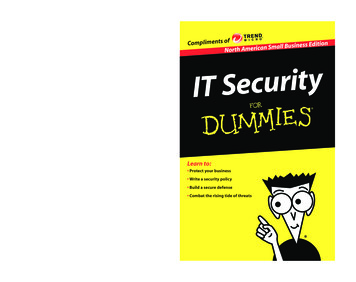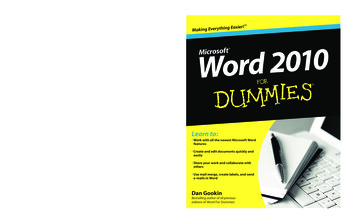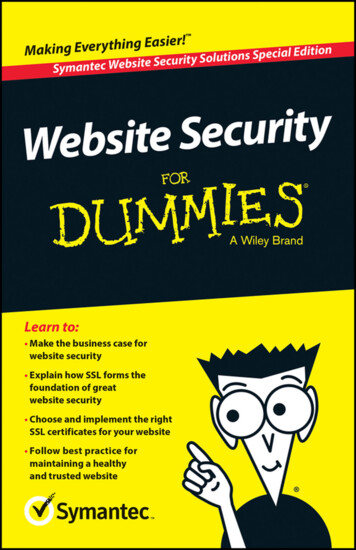
Transcription
Compliments ofess EditionnsiuBllamSncaNorth AmeriStay secure from IT threats Understand security threats — they’reeverywhere; you need to be able to identifyand understand them Develop a comprehensive security policy —even if you don’t know what to expect, youcan figure out how to handle the unexpectedahead of timeOpen the book and find: A list of security measuressmall businesses can take How to gauge the impactof threats on your business Information on educatingemployees A sample acceptable usepolicyytirucIT Se An overview of how threatsevolveMaking Everything Easier! Defend yourself — you need a coordinateddefense that will repel intruders at all levels Know the enemy — understand who’screating the different types of threats andthe best ways to defend against themIT SecurityIT security threats are everywhere and new onesseem to emerge every day. But if you’re a smallbusiness, you have limited resources to protectyour valuable assets. This book gives you thebasics you really need to be secure. Outliningthe major threats and how they could affect yourbusiness, it helps you craft a security policy, puttogether a coordinated defense, and, mostimportantly, manage security better. Cybercriminalsare constantly moving in with new methods ofattack — here’s how to stem the rising tide.Learn to: Protect your businessGo to Dummies.com Write a security policyfor videos, step-by-step examples,how-to articles, or to shop! Build a secure defense Combat the rising tide of threats Figure out solutions — to help fight againstthreats, you need to know who can helpISBN: 978-1-118-08410-6Not for resale
Trend Micro Incorporated, a global leader in Internet contentsecurity and threat management, aims to create a world safe forthe exchange of digital information for businesses and consumers.A pioneer in the antivirus market with over 20 years experience,Trend delivers top-ranked security that fits customer needs, stopsnew threats faster, and protects data in businesses of all sizes.Worry-Free Business Security is a security solution that wasbuilt with a small, growing business in mind. It provides fast,effective, and simple protection against viruses, cybercriminals,and data loss, so you can focus on your business instead ofworrying about Internet securityThese materials are the copyright of Wiley Publishing, Inc. and anydissemination, distribution, or unauthorized use is strictly prohibited.
IT SecurityFORDUMmIES‰NORTH AMERICAN SMALL BUSINESS EDITIONby Trend MicroThese materials are the copyright of Wiley Publishing, Inc. and anydissemination, distribution, or unauthorized use is strictly prohibited.
IT Security For Dummies , North American Small Business EditionPublished byWiley Publishing, Inc.111 River StreetHoboken, NJ 07030-5774www.wiley.comCopyright 2011 by Wiley Publishing, Inc., Indianapolis, IndianaPublished by Wiley Publishing, Inc., Indianapolis, IndianaNo part of this publication may be reproduced, stored in a retrieval system or transmitted in anyform or by any means, electronic, mechanical, photocopying, recording, scanning or otherwise,except as permitted under Sections 107 or 108 of the 1976 United States Copyright Act, without theprior written permission of the Publisher. Requests to the Publisher for permission should beaddressed to the Permissions Department, John Wiley & Sons, Inc., 111 River Street, Hoboken, NJ07030, (201) 748-6011, fax (201) 748-6008, or online at http://www.wiley.com/go/permissions.Trademarks: Wiley, the Wiley Publishing logo, For Dummies, the Dummies Man logo, A Referencefor the Rest of Us!, The Dummies Way, Dummies.com, Making Everything Easier, and related tradedress are trademarks or registered trademarks of John Wiley & Sons, Inc. and/or its affiliates in theUnited States and other countries, and may not be used without written permission. All other trademarks are the property of their respective owners. Wiley Publishing, Inc., is not associated with anyproduct or vendor mentioned in this book.LIMIT OF LIABILITY/DISCLAIMER OF WARRANTY: THE PUBLISHER AND THE AUTHOR MAKENO REPRESENTATIONS OR WARRANTIES WITH RESPECT TO THE ACCURACY OR COMPLETENESS OF THE CONTENTS OF THIS WORK AND SPECIFICALLY DISCLAIM ALL WARRANTIES,INCLUDING WITHOUT LIMITATION WARRANTIES OF FITNESS FOR A PARTICULAR PURPOSE.NO WARRANTY MAY BE CREATED OR EXTENDED BY SALES OR PROMOTIONAL MATERIALS.THE ADVICE AND STRATEGIES CONTAINED HEREIN MAY NOT BE SUITABLE FOR EVERY SITUATION. THIS WORK IS SOLD WITH THE UNDERSTANDING THAT THE PUBLISHER IS NOTENGAGED IN RENDERING LEGAL, ACCOUNTING, OR OTHER PROFESSIONAL SERVICES. IF PROFESSIONAL ASSISTANCE IS REQUIRED, THE SERVICES OF A COMPETENT PROFESSIONALPERSON SHOULD BE SOUGHT. NEITHER THE PUBLISHER NOR THE AUTHOR SHALL BE LIABLEFOR DAMAGES ARISING HEREFROM. THE FACT THAT AN ORGANIZATION OR WEBSITE ISREFERRED TO IN THIS WORK AS A CITATION AND/OR A POTENTIAL SOURCE OF FURTHERINFORMATION DOES NOT MEAN THAT THE AUTHOR OR THE PUBLISHER ENDORSES THEINFORMATION THE ORGANIZATION OR WEBSITE MAY PROVIDE OR RECOMMENDATIONS ITMAY MAKE. FURTHER, READERS SHOULD BE AWARE THAT INTERNET WEBSITES LISTED INTHIS WORK MAY HAVE CHANGED OR DISAPPEARED BETWEEN WHEN THIS WORK WAS WRITTEN AND WHEN IT IS READ.For general information on our other products and services, please contact our Business DevelopmentDepartment in the U.S. at 317-572-3205. For details on how to create a custom For Dummies book foryour business or organization, contact info@dummies.biz. For information about licensing theFor Dummies brand for products or services, contact BrandedRights&Licenses@Wiley.com.ISBN: 978-1-118-08410-6Manufactured in the United States of America10 9 8 7 6 5 4 3 2 1Publisher’s AcknowledgmentsDevelopment Editor: Peter GregoryProject Editor: Jennifer BinghamEditorial Manager: Rev MengleBusiness Development Representative: Karen HattanCustom Publishing Project Specialist: Michael SullivanProject Coordinator: Kristie ReesLayout and Graphics: Melanee HabigThese materials are the copyright of Wiley Publishing, Inc. and anydissemination, distribution, or unauthorized use is strictly prohibited.
Table of ContentsIntroduction. . . . . . . . . . . . . . . . . . . . . . . . . . . . . . . . . . . . . . . . . . . 1About This Book. 2Icons Used in This Book . 2Chapter 1: Evaluating Security Threats . . . . . . . . . . . . . . . . . . . 3Recognizing the Biggest Threats . 3Facing the Impact of Security Breaches . 6Prompting PC, network, or website downtime . 8Dealing with data damage, destruction, or theft . 8Recovering from identity and password theft . 9Facing financial theft . 10Accounting for the response costs . 11Taking a hit to your reputation. 11Assessing the Threat to Your Business . 12Looking at Legal Responsibilities. 14Respecting privacy and communication . 14Treating staff lawfully . 15The Security Industry’s Response . 16Chapter 2: Starting with a Security Policy . . . . . . . . . . . . . . . 17Formulating a Security Policy. 17Sorting out what to include . 18Defining acceptable use . 20Ensuring the policy works . 24Exploring Best Standards and Practices . 25Administering the Security Policy . 26Exploring the Role of Technical Controls . 26Outsourcing Security Functions —The Cloud Option. 28Cloud-based email security . 28Cloud-based endpoint security . 29Chapter 3: Establishing a Coordinated Defense. . . . . . . . . . . 31Controlling Access . 32Shoring up the perimeter . 32Checking ID at the gate . 32Restricting actions . 34Securing Your Phones and Networks . 34Ringing around telephone networks . 35Guarding wireless networks. 36Protecting computer networks . 37These materials are the copyright of Wiley Publishing, Inc. and anydissemination, distribution, or unauthorized use is strictly prohibited.
Managing Security Management . 38Avoiding zero-day attacks . 38Restricting user access . 39Overseeing the technology . 39Ensuring Data Security . 41Realizing the reach of databases . 41Curbing email threats . 41Taking care of data . 42Providing Physical Security . 42Planning for the Aftermath . 43Making Your Users Aware of Your Plans . 45Chapter 4: Knowing Your Enemy . . . . . . . . . . . . . . . . . . . . . . . . 47Guarding Against Today’s Combined Web Threats . 49Looking at lethal combinations . 50Tapping into social engineering . 51Raising the volume . 52Entering the Cybercriminal Underworld . 53Counting the money . 53Employing a host of tools . 54Chapter 5: Devising Practical Solutions . . . . . . . . . . . . . . . . . 55Trying Vainly to Hold Back the Tide. 56Signature files can’t keep up . 57Meeting the New Challenge of Blended Threats . 58Adding on multiple threats . 58Facing danger from the web. 60Finding Security in the Cloud . 60Exploring the Smart Protection Network . 61Looking into the Future of Security . 63Chapter 6: Top Ten IT Security Measuresfor Small Business . . . . . . . . . . . . . . . . . . . . . . . . . . . . . . . . . 65Identify Threats . 65Conduct an Impact Analysis . 65Write a Security Policy . 66Identify Assets and Risk Factors . 66Write an Acceptable Use Policy . 66Write an Internet and Email Policy . 66Establish Technical Controls. 67Coordinate Security Elements . 67Know Your Enemy. 67Harness the Power of Cloud Computing . 67These materials are the copyright of Wiley Publishing, Inc. and anydissemination, distribution, or unauthorized use is strictly prohibited.
IntroductionYou’ve seen the effects of viruses, spam, and spyware oncomputers — infecting files, blocking up e-mail, and, insome cases, even killing off what might otherwise have beenperfectly workable machines. But what’s the impact of all thison a business? You have basic IT security measures in place,but are they enough? And if there’s something sinister goingon in your networks, are you able to detect it?With businesses increasingly trying to do more with less andwith funding tight, security may slip down a few notches onthe priority list — you have so many other things to focuson! But with threats to your IT security coming from all sides,security is an increasingly necessary activity.A small business is particularly susceptible to IT threatsbecause it doesn’t have dedicated IT staff keeping on top ofsecurity updates. But don’t worry; it’s probably easier thanyou think to protect yourself — and reading this book meansyou’re taking the first steps toward that goal.Simply put, investing time and effort in protecting your business helps you avoid cost and harm further down the lineand safeguard future success. This book sets out some of thesecurity basics for a small business owner, examines wherethe major threats are coming from today and in the future,and looks at some new solutions to the growing challenge ofmanaging security.Understanding the threats your business faces, their potentialimpact, and the regulations you need to follow is really theleast any business owner should be doing. Going the extrastep and writing up a security policy — and maybe evenacceptable use policies for staff use of company email andInternet — is about protecting yourself even more.These materials are the copyright of Wiley Publishing, Inc. and anydissemination, distribution, or unauthorized use is strictly prohibited.
2IT Security For DummiesAbout This BookThis book shows that investing in security doesn’t have to bea particularly expensive or time-consuming business. In fact,you’re probably already taking many of the necessary security measures; you just need to make sure your various toolsand protections are working together. Investment in securitydoesn’t have to be particularly onerous or expensive; in fact,it’s getting easier and cheaper.You read every day about the cybercriminals out to geteveryone. Increasingly their focus isn’t just big business, butsmaller companies, too. Chances are, smaller companies don’thave such strong defenses, and can’t afford the top consultants to help tighten them up. But small and midsize companies rely on technology, too — take out their web serveror steal their mailing list and they’re in a lot of trouble. Thegood news is that it’s getting easier to monitor and managesecurity. Plus, the integrated technical controls that vendorsoffer are getting more sophisticated and more rounded, anddifferent options are emerging to make it more affordable forcompanies of all sizes.This book was written for and with Trend Micro, with information supplied by them.Icons Used in This BookFor Dummies uses icons in the margins to highlight specificinformation. The icons in this book are:The information next to this bull’s-eye is something you canput to use immediately.This icon points out information to keep in mind as youexplore the topic.Especially dangerous practices get this scary-looking icon.These materials are the copyright of Wiley Publishing, Inc. and anydissemination, distribution, or unauthorized use is strictly prohibited.
Chapter 1Evaluating Security ThreatsIn This Chapter Discovering the type of IT threats a small business faces Gauging their potential impact on your business Prioritizing your biggest issues Seeing what regulations you need to follow Assessing the security industry’s changing responseThis chapter identifies the frequent offenders: the security threats that come back to bite businesses time andagain. It also looks at the possible impact of these threats onyour business — from network downtime to financial loss anddamage to your reputation with partners and customers.Without getting carried away with doom-mongering predictionsof impending Information Technology (IT) meltdown, there arecertain risks you need to be aware of and regulations you needto follow. Planning ahead for potential disaster means if it doescome to pass you won’t be flapping around in a panic.Recognizing the Biggest ThreatsEver since computer systems and networks were introducedinto small businesses in the 1980s, various threats have hammered at the security of those systems. Whether you’re aglass-half-full type and you think these dangers have been overstated, or a conspiracy theorist who thinks they’ve been playeddown, what is certain is that they aren’t going to go away.These materials are the copyright of Wiley Publishing, Inc. and anydissemination, distribution, or unauthorized use is strictly prohibited.
4IT Security For DummiesThe Verizon Business/United States Secret Service annualsurvey of data breach investigations found that 27 percent ofall security incidents occur in companies with fewer than 100employees. Twenty-seven percent may not seem like a lot, butif you have fewer than 50 employees and no dedicated IT staff,every security breach is not only a major pain, it can also be ahuge drain on your resources.Being savvy about the threats is the first step toward facingup to them. In these days of identity theft, spam and spyware(unwanted software on users’ computers that secretly monitors their activity, with the intention of recording businessand personal information and passing it on), you may be surprised at how fundamental some of the biggest threats are.According to the Verizon/Secret Service survey, the most serious types of incidents experienced by U.S. businesses werethe following, with the events ranked in order of frequency: Staff misuse of information systems Hacking and other attacks by outsiders Malware infection or disruptive software Social tactics aimed at exploiting employees throughdeception, manipulation, intimidation, and so on. Physical attacks like theft, tampering, and surveillance Errors, meaning anything not done or anything doneincorrectly or inadvertentlyThere is another angle to these statistics. If we consider theamount of data compromised by an attack, malware and hacking account for over 90 percent of security breaches, whereasthe other causes are each under 5 percent. So in terms of dataloss — the most potent threats to businesses are malware andhacking attacks.The Verizon Secret Service study stated that 86 percent ofsecurity breaches were compromises that took place on servers and PCs. An incredible 98 percent of data stolen was takenfrom servers. That tells us that PCs and servers need betterprotective measures than they’re getting today.These materials are the copyright of Wiley Publishing, Inc. and anydissemination, distribution, or unauthorized use is strictly prohibited.
Chapter 1: Evaluating Security Threats5A glossary of key threatsKnowing your backdoor from yourbot is valuable knowledge in therealm of IT security, so check out thedefinitions in the following list: Adware: Software that displays advertising banners onweb browsers such as Firefox,Internet Explorer, and Safari. Backdoor: Application thatopens computers to access byremote systems. Bot: Remote-controlled malwarethat infects computers; a collection is known as a botnet thatis controlled by a bot herder orbotmaster. Denial of Service (DoS) attack:An attack that interrupts or inhibits the normal flow of data intoand out of the system, ultimatelyrendering it useless. A DoSattack is any malware or actionthat stops the normal functioningof a system or network. Drive-by: a malware attack whereattackers implant malware on awebsite; malware will be installedon the computers when users visitthose infected sites. Hacker: a person or organization that develops or distributesmalware or carries out attackson target systems. Keylogger: Spyware that recordsand reports on keystrokes; oftenused to collect username andpassword information that issent back to the keylogger’sowner. Malware: Short for malicioussoftware, it’s any malicious orunexpected program or code,including viruses, Trojans,worms, bots, and spyware. Pharming: An attack on enduser workstations or IT serversthat causes users’ browsers toconnect to hackers’ imposterwebsites instead of the sites thatusers intend to visit. Often this isdone with online banking andother high-value sites in orderto steal login credentials fromunsuspecting users. Phishing: Technique in whichusers are duped by legitimatelooking emails into handingover personal data to a boguswebsite. Rootkit: A collection of tools ahacker uses to mask intrusionand obtain access to a networkor system in a way that is difficultto detect. Spam: Unsolicited junk email;can contain malicious code inattachments or links to maliciouscode stored elsewhere. Spoofing: Programming computers to impersonate others. IPspoofing uses a fake IP addressto access a network.(continued)These materials are the copyright of Wiley Publishing, Inc. and anydissemination, distribution, or unauthorized use is strictly prohibited.
6IT Security For Dummies(continued) Spyware: Unwanted software thatsecretly monitors a user’s activity, generally recording personalinformation and passing it on. Trojan: A type of malware thatappears harmless, but has somehidden malicious intent. Virus: Code written with theintention of replicating itself. Avirus attempts to spread fromcomputer to computer by infecting other files. Worm: Type of malware that canspread copies of itself or its segments across networks. Zero-day exploit: Malwareexploiting a newly discoveredvulnerability in a system beforea patch (fix) is made available.And, before you get comfortable, thinking your business is safefrom all these threats, we’ll just point out the ever-changingnature of IT threats. In the past, malware and hacking attackswere mostly carried out by kids (security professionals callthem “script kiddies”) who were bored and needed somethingto do. But today, most break-ins are carried out by organizedcrime gangs and organizations that have deeper resources andare highly skilled. We offer advice on how to keep your systemsafe from these threats in Chapter 5.As IT gets more sophisticated, don’t forget to account for thefundamental threats. Staff misuse of systems is at the top ofthe current threat list. Perhaps, with the greater sophistication of security systems, some businesses are forgetting tolock the windows and doors.Facing the Impact ofSecurity BreachesSecurity breaches can seriously hamper your business —from financial losses to damaging your business’s reputation.According to a Ponemon Institute study, the mean corporateloss to IT security breaches in 2009 was 3.8 million. In thestudy, companies that suffered a breach spent an averageof 18,000 per day for as long as 14 days to remediate thebreach.These materials are the copyright of Wiley Publishing, Inc. and anydissemination, distribution, or unauthorized use is strictly prohibited.
Chapter 1: Evaluating Security Threats7The Digital Forensics Association also performed a study ofmore than 2,800 publicly disclosed security breaches over afive-year period. The average cost of a breach in that studywas about 9 million.These are pretty sobering figures. Often, a combination ofrepercussions from a breach creates even bigger problems.For a smaller company, the most serious issue may be business continuity or lost productivity. The direct financialdamage plus the cost to remediate a breach can seriouslythreaten a smaller company’s long-term viability.Dependent as you are on IT today, the disruption to everydayrunning of the business can be catastrophic. Just consider thefollowing scenarios: Your network has an outage, or the server isn’t performing properly. What is the financial impact of each hour oflost productivity? Your website goes down and you lose a day’s worth oforders. What’s the damage going to be to your incomeand to your reputation? Your employees spend time surfing websites that areunrelated to your business, such as Facebook or Twitter.How much does this cost you in lost productivity, andwhat risks does it pose to your IT system?Employees can directly damage your reputation by surfing content on the web they legally should not. Indirectly,their web browsing can threaten the business by bringing in malware that can infiltrate one of your PCs andinstall spyware or a botnet on computers that containcompany data. This can cause the spyware or botnet tospread to more computers in your business and be verydifficult to clean up afterwards.According to the Verizon/Secret Service survey, the number ofpublicly disclosed breaches fell a little in 2009. However, it onlytakes one calamitous event to take your whole business down.Consider the hidden impacts of security breaches. Often themost serious issues are the ones you don’t immediately thinkof, such as the loss of a key piece of business informationthat you need to complete a deal, or the passing of data into acompetitor or criminal’s possession.These materials are the copyright of Wiley Publishing, Inc. and anydissemination, distribution, or unauthorized use is strictly prohibited.
8IT Security For DummiesCheck your insurance to make sure that you’re insuredagainst the financial losses related to a data security breach.Put disaster recovery and business continuity measures inplace so that you can get back up and running in the shortestpossible time after a security event.The following sections lay out some of the impacts of securitybreaches.Prompting PC, network,or website downtimeAlmost all security incidents cause some form of downtime.A serious incident can take a PC, network or web server outof operation altogether. Even a less serious problem, such asa denial of service attack (an effort to prevent your customersand employees from accessing a system or network) can slowyour network to a crawl.Timing can be critical; if your PC is taken out of action whenyou’re working on a pitch for a new piece of business, who’s tosay what the ultimate cost of that downtime is? Equally, if yourwebsite’s not available when a customer wants to place anorder or ask a question, that customer may never come back.A slowdown tests the effectiveness of your contingency plansin full. With good disaster recovery or business continuityarrangements in place, you can restore lost data or switch toa redundant machine or network and continue working as ifnothing has happened.Dealing with data damage,destruction, or theftYou may not realize it, but most businesses are dependenton data to function properly. Like it or not, data oils thewheels of business — from the most basic customer namesand addresses, to the fundamental intellectual property thatmakes your products and services unique, to the mundaneadministration of payments and invoices. Having that confidential data damaged, destroyed, or stolen can cause you lotsof grief.These materials are the copyright of Wiley Publishing, Inc. and anydissemination, distribution, or unauthorized use is strictly prohibited.
Chapter 1: Evaluating Security Threats9The theft of customer information can be highly damaging.How many times has a salesperson left a company takingits biggest clients with him? Or, in the case of intellectualproperty, how often has a company director left to start upanother business, which ends up doing something remarkablysimilar to the one she left? Incomplete or missing data can beequally damaging, and its absence only tends to be realizedafter the fact, when it comes to enforcing contracts or dealingwith company administration. Larger companies have safeguards in place to prevent this sort of thing happening; forsmaller companies they’re an all-too-common occurrence.Data-stealing malware is, according to the latest researchfrom TrendLabs, now one of the fastest growing categoriesof threat. It comes in several forms, and you may not evenknow that it’s going on. The primary goal is to capture sensitive data from users’ PCs and secretly send it back to criminaloperators either for direct exploitation or resale on the blackmarket.It can be difficult to know if your data has been stolen,because usually it is still on your system and it is just a copythat has been stolen.Recovering from identityand password theftEveryone now knows the dangers of identity theft in the consumer environment, but you may not know that it’s equallyserious in the business arena. By stealing passwords andentry codes, fraudsters can pose as company officials.Because company accounts usually run on credit terms, impostors posing as company directors can run up sizeable debtsbefore being found out. Then when it comes to settling a bill atthe end of the month, the company has a nasty surprise.According to online security group Get Safe Online, corporateidentity theft can take many forms including: Setting up a merchant account in your company’s nameand then accepting lots of purchases using stolen creditcards and depositing the receipts in the criminals’ bankThese materials are the copyright of Wiley Publishing, Inc. and anydissemination, distribution, or unauthorized use is strictly prohibited.
10IT Security For Dummiesaccount. By the time people complain and the credit cardcompany comes to you for the chargebacks, the thieveshave disappeared with the money. Rifling through rubbish bins to get employee
Department in the U.S. at 317-572-3205. For details on how to create a custom For Dummies book for your business or organization, contact info@dummies.biz. For information about licensing the For Dummies brand for products or services, contact BrandedRights&Licenses@Wiley.










